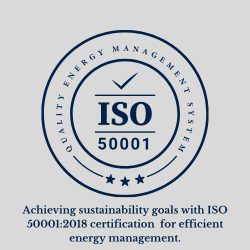ISO 50001:2018

ISO 50001:2011 specifies requirements for establishing, implementing, maintaining and improving an energy management system, whose purpose is to enable an organization to follow a systematic approach in achieving continual improvement of energy performance, including energy efficiency, energy use and consumption.ISO 50001:2011 specifies requirements applicable to energy use and consumption, including measurement, documentation and reporting, design and procurement practices for equipment, systems, processes and personnel that contribute to energy performance.
Why Get ISO 50001:2018 Certified?
ISO 50001:2018 is the international standard for Energy Management Systems (EnMS), providing a framework to manage and improve energy performance. Here are the key reasons why organizations pursue this certification:
Energy Efficiency Improvement: ISO 50001 enables organizations to improve energy efficiency systematically, reducing energy consumption and lowering utility costs.
Cost Savings: By optimizing energy use and reducing waste, organizations can significantly cut operational costs, leading to long-term financial savings.
Regulatory Compliance: The standard helps ensure compliance with energy-related regulations and policies, reducing the risk of non-compliance fines and penalties.
Reduction in Environmental Impact: The efficient use of energy reduces greenhouse gas emissions, aligning organizations with global sustainability goals and corporate social responsibility (CSR) objectives.
Competitive Advantage: Certification demonstrates a commitment to sustainability and responsible energy management, making an organization more attractive to customers, investors, and partners who prioritize environmentally conscious suppliers.
Improved Risk Management: The standard promotes a proactive approach to managing energy-related risks, such as volatile energy prices and supply disruptions.
Enhanced Reputation: Certification strengthens an organization’s reputation as an environmentally responsible and energy-efficient business, contributing to its overall brand image.
Employee Engagement: Implementing an energy management system fosters a culture of energy efficiency and sustainability, increasing employee awareness and engagement.
Steps to ISO 50001:2018 Certification
Familiarization and Planning:
- Understand the ISO 50001:2018 standard, including its requirements and the benefits it offers.
- Secure top management support to develop and implement an Energy Management System (EnMS).
- Define the scope of the EnMS and establish an energy policy aligned with the organization’s goals.
Initial Energy Review:
- Conduct an energy review to assess current energy usage, identify significant energy-consuming processes, and determine opportunities for improvement.
- Establish baseline energy performance indicators (EnPIs) for measuring progress.
Gap Analysis:
- Perform a gap analysis to compare existing energy management practices with the ISO 50001:2018 requirements.
- Identify gaps and create an action plan to bridge them.
Energy Management Team and Responsibilities:
- Form an energy management team responsible for implementing and maintaining the EnMS.
- Define roles, responsibilities, and authorities for energy management within the organization.
Training and Awareness:
- Provide training to employees on energy efficiency, the objectives of ISO 50001, and their roles in the system.
- Raise awareness across the organization about the importance of energy management and the benefits of certification.
Develop and Document the EnMS:
- Develop the necessary documentation, including energy policies, procedures, objectives, and action plans for improving energy performance.
- Ensure the EnMS includes procedures for monitoring, measuring, and reporting on energy performance.
Energy Performance Objectives and Targets:
- Set measurable energy performance objectives and targets based on the initial energy review and baseline data.
- Create an energy action plan outlining the specific measures and projects to achieve these targets.
Implementation:
- Implement the EnMS across the organization, integrating energy management practices into daily operations.
- Ensure that energy-efficient technologies and processes are in place and that all staff adhere to the energy management procedures.
Monitoring, Measurement, and Analysis:
- Continuously monitor and measure energy performance against the established baseline and objectives.
- Analyze data to identify areas for improvement and adjust action plans accordingly.
Internal Audits:
- Conduct regular internal audits to evaluate the effectiveness of the EnMS and ensure it meets ISO 50001:2018 requirements.
- Address any non-conformities found during the audits and make continuous improvements.
Management Review:
- Perform a management review of the EnMS to ensure that energy performance objectives are being met, identify opportunities for improvement, and ensure the system remains effective.
Pre-certification Audit:
- Engage with an accredited certification body for the certification process.
- The certification audit typically involves two stages:
- Stage 1 Audit: A preliminary review of documentation and system readiness.
- Stage 2 Audit: A comprehensive audit of the EnMS to verify its implementation and compliance with ISO 50001:2018.
Certification and Ongoing Surveillance:
- After successfully passing the certification audit, your organization will receive ISO 50001:2018 certification.
- The certification is valid for three years, with periodic surveillance audits to ensure continued compliance and improvement in energy performance.
